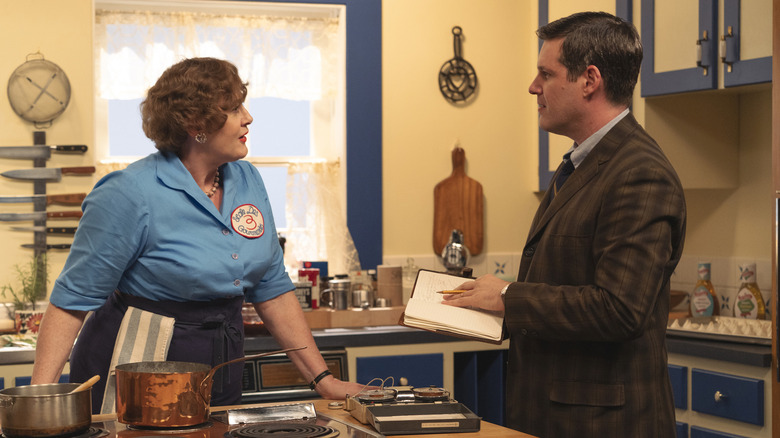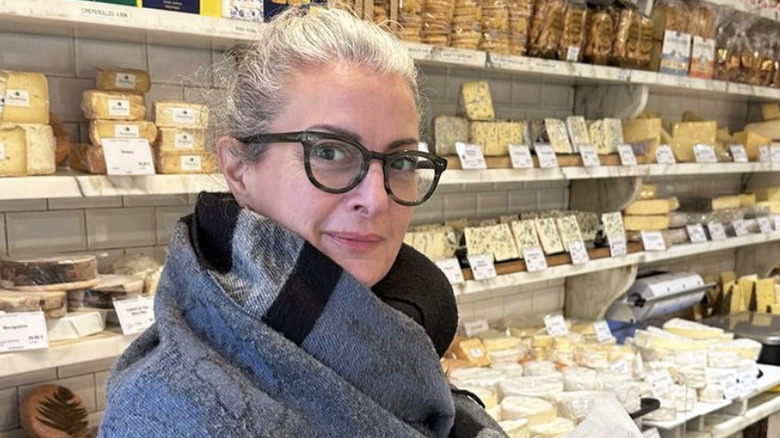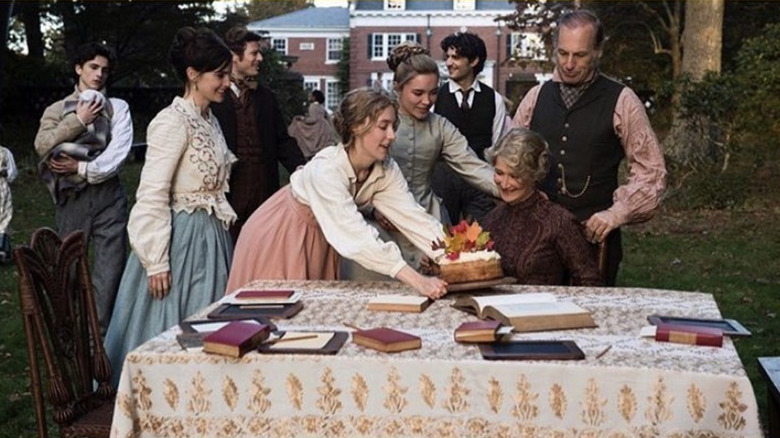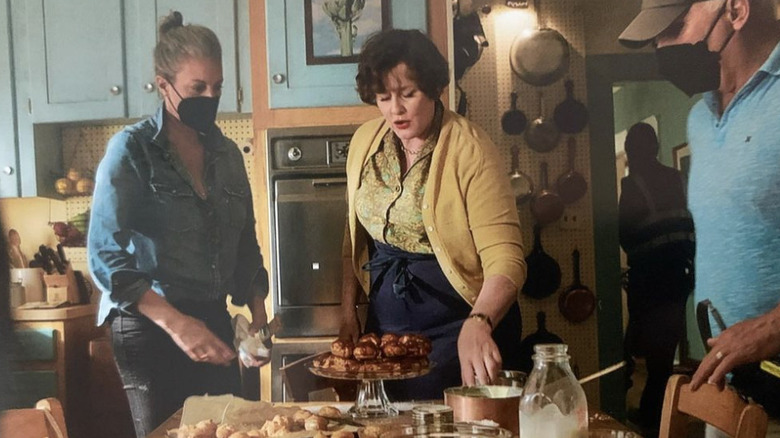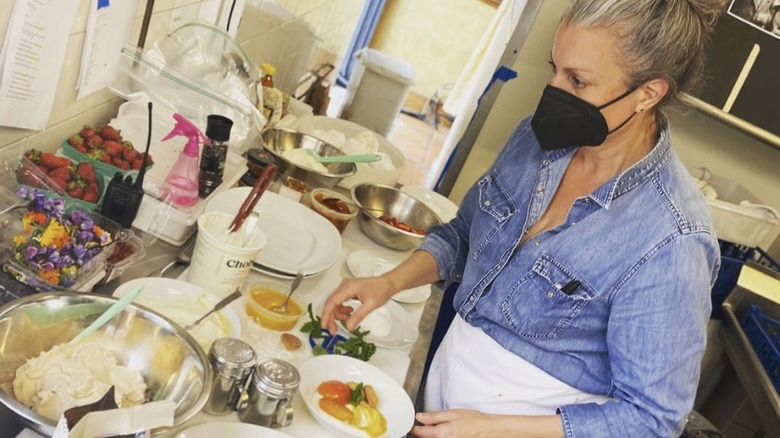Food Stylist For Max's Julia Gives Us A Behind-The-Scenes Look At What Her Work Entails - Exclusive Interview
Whether you're watching a movie that features a decadent tablescape full of colorful pastries or a cozy dinner scene with pasta for two, that's created by a food stylist. Christine Tobin has been working in this field for more than 20 years and has worked on hit films and television shows including "American Hustle," "Little Women" and HBO Max's "Julia," based on the prolific life of Julia Child.
Tobin told us in an exclusive interview that she felt immense pressure to get Child's iconic recipes right because she knew they'd be under a microscope for culinarians. Now in its second season, the critically acclaimed series focuses on Child's meteoric rise to fame in the 1960s showing Americans how to cook on WGBH's groundbreaking show "The French Chef."
Interestingly, while Tobin has created an impressive mark in the world of cinema, she admitted that she didn't even know a career like this existed for women in the 1980s and instead initially pursued graphic design. The Massachusetts native revealed how she ultimately got her break in the industry, some of her most challenging scenes to film, and what she hopes viewers take away from watching "Julia."
What a career as a food stylist involves
How did you initially get involved in this type of work?
I've been a food stylist for over 20 years. I started with print work before. What led me into that was fine arts training and being a gallery artist, and what led parallel to that is my working in restaurants to pay my way through school and pay my way to be a working artist. That's what led me into the craft of food styling. Food on film, it's been 13 years and that was from a call based on a referral from my still work to get into motion, and it clicked.
It's more of a match of the mental and the physical, similar to when you work at a restaurant. I find working on a set very similar ... I was taken by it. It's grown through the years from 20-something projects and seeing the momentum and the gaining of the power of food as a tool and narrative to get to this point.
Can you explain what a typical day as a food stylist involves?
It's different from production to production as far as the culinary needs of the day. Here, with "Julia" my day starts probably two hours pre-call, and that's to prepare the food and get organized and prepared for the scenes that are that day. Sometimes it's just one scene, sometimes it's up to three scenes, and sometimes it's two different locations that I get shuttled back and forth from.
We have a food truck that helps us establish those moves from our commissary kitchen on the stage. It's pretty full on every day. This is an enigma of a situation for a craft of food, being a full-time position. If I'm not on a set or need to be on set, those days are filled with meetings or planning outlines, working with other departments, and planning the execution of the next scene.
Have you always had a passion for the culinary arts?
I've always followed my stomach wherever I've gone. I was the kid who would eat three helpings of my mom's or my dad's cooking every night. Food is a big part of my upbringing. When I was young, I was tuning into Julia Child and Bob Ross. Back then, not to age myself, but I was born in the '70s, and going into the '80s in high school, culinary arts, especially for women, wasn't really a thing. It wasn't discussed as much as being a graphic designer, which is what I first went to school for and then went into fine arts. I found that to be more of my medium. All my training has led me to this point, and I definitely feel it while I'm on set.
Her first big break and favorite experience on the set of 'Little Women'
That's interesting that you didn't even know a job like that existed until the opportunity presented itself.
I was working at Oleana in Cambridge when I first got tuned into food as a medium by watching the chef present food ... I then gained the peak interest of what food styling is and that there is an actual profession, but it's a really hard profession to get into and start in.
I had my first opportunity, based on a friend who I worked with, that let the cat out of the bag and said, "Christine wants to be a food stylist." [And she said,] "Oh, well, I need a food stylist for this book." That's how it started. I started assisting many different types of food stylists in New York, and I'm based in Boston, and then I would travel to New York. I've gone as far as Atlanta in training with working with various food stylists, and then it takes time to then get your own clients.
You've created food displays on everything from "Little Women" to "Ghostbusters." What's been your favorite cuisine to create on set?
Any chance I get to design a tablescape or help establish a food set dressing, I really love that. In addition to that, any opportunity that I get to serve talent with beautiful foods or an assistant comes to me and says, "So-and-so wants to take some to their trailer," or they ask for seconds or they say, "I just overdid it. I ate so much. It was so delicious," those are those moments as a food maker that I really enjoy.
What's been your most challenging food to create on set? I would imagine a film like "Little Women" would be difficult, because it's a time-period piece.
I love period pieces, just because of the research that goes into it. It definitely utilizes another part of my brain, in an academic way, to do the heavy digging. It's a blessing and a curse at this point. I have this ability to, when I see a recipe or if I read someone's writing, I can taste it. I can see it. That leads to designing the visuals that would be seen on a table or in a surrounding or with an actor to be engaged with.
"Little Women" was a place where I felt very free, creatively, to use the book and then work within departments and work with our director, Greta [Gerwig], and have magic happen. That was really unexpected, because no one knew what would be there up until the very moment that the girls came into that set. No one knew what foods were on that table. I felt that moment of the power of food as a presentation, and how it was when it was captured on camera is something that I'm super proud of.
She recreates Julia Child's recipes using real food
For the show "Julia," do you recreate Julia Child's recipes for taste or is it purely aesthetic?
It's a bit of both, but honestly, it's protecting myself and protecting Julia, too. If I'm to present something that is not true to what is being talked about or presented or cooked or engaged with, say, on the set of GBH with "Julia," that's a great responsibility. I keep it simple, and I'm using her recipes to keep it as simple and clean as possible so there's no confusion, because you go back and look at the footage of the actual "French Chef" and we didn't have color then. We didn't have food photography. I have some ability to enhance things a little bit, but I like her food to look like her food. That's what people are going to be making if they're [inspired] and they go to the cookbooks.
You touched on this a bit, but since Julia Child is such a beloved figure, did you feel pressure to get every detail of her food right?
Yeah, I owed it to her and also to all culinarians that would have this work under a microscope. I felt far more pressure during Season 1 of that, whereas in Season 2, I felt from the reactions and from the conversations that were brought on after Season 1 and the capacity of food, I felt a little bit more comfortable and able to make a bit more bold choices and have more wiggle room creatively. I stayed true to her, especially with what was scripted. I could play around with what would look good on a table or on a set that would make sense to a recipe.
Food commercials often use things like wax, hairspray, or even shaving cream to make meals look more appealing on camera. Do you use any products like that to enhance them?
No. If you look at the doll cakes in the episode with the bridal shower, we used a real buttercream, and it was a hot, humid day. I love that scene as an example, because that is how we behave under those circumstances. That's exactly how it would behave in that setting, in that time. There was real cake underneath, because we never know if someone's going to want to cut into it or not. I don't use shaving cream. I'm not opposed to it, but I've never been asked to go that route. I'm lucky to have the ability to make real food on each project I've ever been on.
The toughest Julia Child dish to recreate this season
Do you have any easy techniques you employ to make a dish look extra decadent?
I definitely advise people to stop touching their food as much as people do or think that they have to. I flip-flop and put it on a beautiful platter and add some herbs and some texture, maybe if it needs it, or a splash of a really nice olive oil to give it a bit of sheen. With baked goods, especially cakes and things like the pastry end, I like to think of it as architecture. You can conceptualize it and even jot it down, do a little sketch, and then it's your playground.
I read that last season, one of the most challenging "Julia" recipes to recreate was the soufflé. What was the toughest this season?
We had a few. For the bûche de Noël scene, we had burnt sugar to make these nests that go around ... it's in her cookbook, and she would make these webs of spun sugar. We were on the other side of the wall, and because we're dealing with a very hot liquid candy, a caramel, it had to move super-duper fast so they can then take it and have it be laced and put around the cake on the set. That was a really tough scene that we had to practice in advance and not just for ourselves as the food makers, but also for the assistant directors and the director and the actors to understand how this element works in the chemistry of food.
What do you ultimately hope people take away from the show after watching "Julia?"
There are so many things to take away from it because it's so rich, not just in the storytelling of Julia Child herself and Paul Child, but as her being a trailblazer. Every one of those characters are trailblazers and have helped shape not only our culinary landscape but also our public television landscape, food television landscape, writing, and storytelling. It's very refreshing to me to watch it because in today's time, it is daunting and uncertain, and to revisit this time that we're in on "Julia," there's not much of a difference. At least there's comfort in knowing that it takes time for change and time to build something that you're passionate about.
New episodes of "Julia" premiere Thursdays on HBO Max.
This interview has been edited for clarity.
